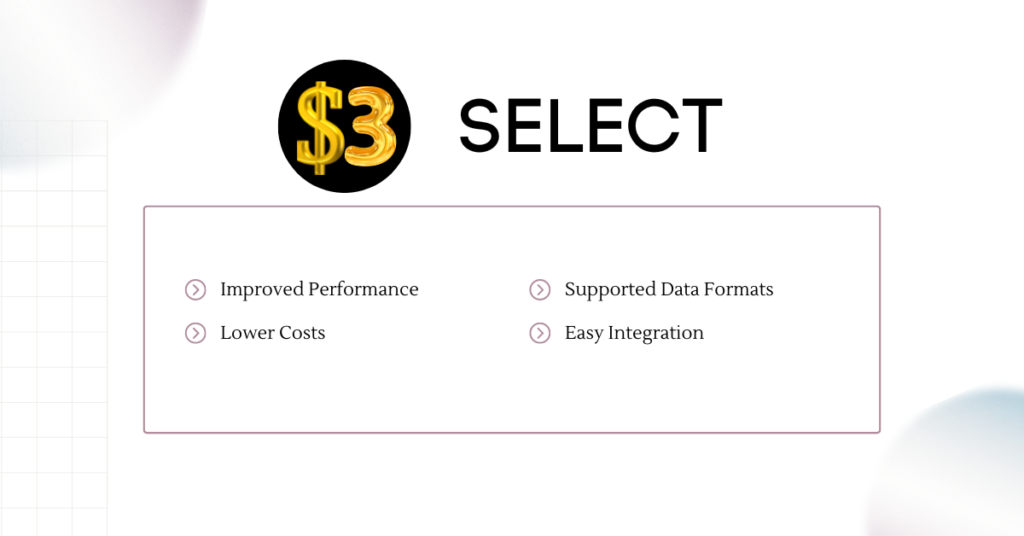Querying data using Amazon S3 Select

Using Amazon S3 Select, you can filter the contents of an Amazon S3 object and retrieve a subset of data using SQL statements. S3 Select can reduce the amount of data that needs to be transferred from Amazon S3, lowering the cost and latency of data retrieval.
Key Benefits
- Improved performance: S3 Select allows you to retrieve only the data you need, rather than downloading an entire object. This can improve the performance of your applications and reduce their resource usage.
- Lower costs: By retrieving only the data you need, you can reduce the amount of data transferred and lower your S3 storage and data transfer costs.
- Easy integration: S3 Select can be easily integrated with other AWS services like AWS Lambda.
- Query flexibility: S3 Select supports a variety of query operations, including projection, filtering, and transformation, allowing you to extract and transform data in a variety of ways.
- Supported data formats: S3 Select supports a range of data formats, including CSV, JSON, and Parquet, making it easy to work with data stored in S3.
Here is an example of how to use the select_object_content method of the boto3 Python library to retrieve a portion of data stored in an S3 object:
This code will retrieve the Movie Names from the “TOP 1000 IMBD Movie” dataset having “MovieRating” greater than 9.0 from an object (Top1000IMDBmovies.csv) stored in an S3 bucket (awss3selectexample) and process it using the SQL expression
SELECT MovieName FROM s3object s WHERE s.MovieRating > ‘9.0’
The object is assumed to be a CSV file with a header row, and the response will also be in CSV format. The records in the response will be decoded using the UTF-8 encoding and printed to the console.
Prerequisites
You can use S3 Select with the Amazon S3 REST API and the AWS SDK to select content from objects.You have to preapre your local environment to test the AWS S3 Select feature , below are few of the prerequisites.
- AWS CLI – to configure AWS named profile.
- AWS Boto3 – to leverage the AWS S3 Select feature.
- A Dataset – to work with, you can find a lot of free datasets from Kaggle.com
- Upload the Dataset file to the AWS S3 Bucket.
Code
- You can download the code and dataset file from the github repository.
- In line 8, replace the bucket’s name with your Bucket Name.
- In line 9, replace the bucket’s object(file) name with your object name.
- In line 12, you can modify the Select SQL query to test different scenarios.
import boto3
# Create an S3 client
session = boto3.Session(profile_name='abhi')
s3 = session.client('s3')
# Set the name of the bucket and object to retrieve
bucket = 'awss3selectexample'
key = 'Top1000IMDBmovies.csv'
# Set the SQL expression to use for processing the object
expression = "SELECT MovieName FROM s3object s WHERE s.MovieRating > '9.0'"
# Set the response format for the data
response_format = 'CSV'
# Set the encoding for the data
encoding = 'UTF-8'
# Set the desired output serialization for the data
output_serialization = {
'CSV': {
'QuoteFields': 'ASNEEDED',
'RecordDelimiter': '\n',
'FieldDelimiter': ',',
'QuoteEscapeCharacter': '"'
}
}
# Set the input serialization for the data
input_serialization = {
'CSV': {
'FileHeaderInfo': 'Use',
'RecordDelimiter': '\n',
'FieldDelimiter': ','
}
}
# Use the S3 client to retrieve the object and process it using S3 Select
response = s3.select_object_content(
Bucket=bucket,
Key=key,
Expression=expression,
ExpressionType='SQL',
InputSerialization=input_serialization,
OutputSerialization=output_serialization
)
# Get the records from the response
records = response['Payload']
# Iterate over the records and print each one
for record in records:
if 'Records' in record:
payload = record['Records']['Payload'].decode(encoding)
print(payload)
elif 'Stats' in record:
print(record['Stats'])
elif 'End' in record:
print(record['End'])
Output
In the given dataset, only two movies have Movie Ratings greater than 9.0

Conclusion
In Summary, S3 Select is a valuable tool for executing SQL queries on data stored in Amazon S3. It allows you to process data stored in S3 programmatically and search for specific data within it, improving performance and reducing costs. Additionally, S3 Select can save you time and money compared to other data analysis methods.